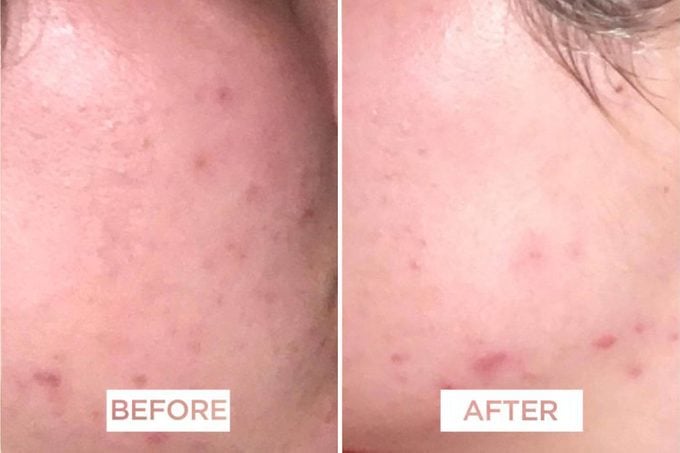How I Cured My Cystic Acne in 3 Weeks
Updated: Nov. 02, 2019
Going to the dermatologist was the best thing I've ever done for my skin.
Let me preface this by saying that my skin’s never really been that bad. In fact, my skin was pretty clear throughout puberty, middle school, high school, and college. Sure, I’d get an occasional pimple (especially around my period), but I never had to deal with daily acne struggles. Unfortunately, this changed when I turned 22. Painful cystic acne popped up around my chin, mouth, and jawline.
My mom, who owns a medical spa, taught me the importance of a good skincare regimen. She initially attributed my acne to environmental stresses associated with moving across the country and starting a new job. My gynecologist agreed and put me on a low-dose birth control pill to help stabilize my hormone levels. Incidentally, here’s everything you need to know about hormonal acne and how to clear it for good.
Feeling embarrassed and defeated
The birth control pills certainly helped. I had fewer breakouts, which was great. However, they didn’t clear up my cystic acne entirely. I was left feeling embarrassed and defeated.
I went from rarely ever wearing makeup to applying heavy foundation before leaving the house.
Feelings of frustration and confusion set in. After all, I took good care of my skin. I washed my face every morning and before going to bed. I also applied my serums, moisturizers, and sunscreen religiously. Still, my acne remained.
Spironolactone for acne
My mom encouraged me to see a dermatologist to discuss whether oral antibiotics could help my acne.
I saw Maryann Mikhail, MD, a dermatologist in New York, NY. She examined my skin under a giant magnifying glass and explained that I was definitely experiencing hormonal acne. The giveaway? My pimples were located in the “beard area.”
She prescribed 20 milligrams of spironolactone to take twice daily, along with a very simple skincare regimen. That regimen consisted of washing my face with a gentle cleanser every morning and evening. After, I applied moisturizer. In the mornings, I used SPF. I stopped using all my serums, retinoids, and face masks.
What exactly is spironolactone?
Spironolactone is an oral medication. It’s typically used to help manage high blood pressure or fluid retention issues. However, it’s also used as a hormonal acne treatment.
In fact, a 2017 study published in the International Journal of Women’s Dermatology assessed spironolactone’s effectiveness for women with acne. The study found that 84 percent of the women showed improvement. Also, more than half of the women who used spironolactone for acne then fell to a zero (no or hardly-visible lesions) on the comprehensive acne severity scale. Although this was a relatively small study and more studies are needed to continue determining its efficacy and safety (it’s not yet approved for acne treatment by the Food and Drug Administration), this particular research suggests mostly positive outcomes.
The American Academy of Dermatology notes that dermatologists have “been prescribing it for many years to treat acne and excess hair growth in women.” Specifically, they say spironolactone is particularly effective in treating “deep-seated, tender acne on the lower face, jawline, or neck” when other treatments don’t work.
Why spironolactone for acne works
“Spironolactone is an androgen blocker,” says Dr. Mikhail. “We know that women with hormonal acne either have too much androgen or are too sensitive to androgens, so blocking the androgens from hitting the skin clears the breakouts.” There are many ways to treat every type of acne though, so make sure you do what’s best for you.
“Good candidates for spironolactone are women who present with cyclical breakouts on the lower face and who are not planning pregnancy,” says Dr. Mikhail. It may be helpful for women who have some acne on their chest or back too. She adds that it can work for women whose acne returns after a course of antibiotics or isotretinoin. Dr. Mikhail also says that spironolactone can help control polycystic ovary syndrome-related acne.

Cystic acne cured
In one week of taking spironolactone for my acne, I saw significant improvement. The cystic acne bumps that I had along my jawline began to disappear and no new pimples popped up. At about three weeks, my cystic acne cleared up almost entirely.
I recently saw Dr. Mikhail for my follow-up, and she was very pleased with how fast my skin responded. I’ve been on the medication for a month now, and my skin is the best it’s been in about four years. My cystic acne has cleared up completely. If your acne still isn’t clearing up, find out what the acne on every part of your body is trying to tell you.